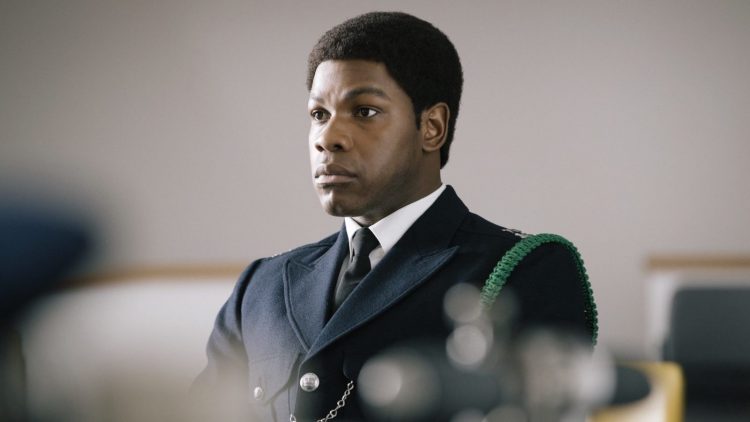“Red, White and Blue”, the third film of Steve McQueen’s “Small Axe” miniseries, will wrap up the five-part anthology when it premieres at the end of November on Prime Video. The series covers five stories of West Indians living in Britain between the 60s and the 80s, with four of them based on history.
“Red, White and Blue” traces the experiences of Leroy Logan, a forensic scientist who yearns to be a bridge between his community and the police system in Britain. His ambition to change the system from within propels him to become a police-officer. His journey is less straightforward.
“Red, White and Blue” is immediately distinguished from the other two “Small Axe” entries that have premiered at the New York Film Festival for the singularity of its focus. Whereas “Lovers Rock” and “Mangrove” emphasised communal stories, “Red, White and Blue” is significant as a character-study of Leroy’s hope, and then growing disillusionment, for the justice system in his country. There are two critical moments that seem to spur Leroy’s desire. A childhood encounter with a police officer, interrupted by his forceful father, opens the film. An incident years later, where his father is brutally beaten by a pair of officers, feels even more impactful. For Kenneth, Leroy’s Jamaican father, the incident calcifies his resentment of the police. For Leroy, the incident is a chance to mend the broken relationship between black people and the police.
Leroy’s journey through the police training punctuates his difference. His blackness stands out in a sea of whiteness as he thrives in the training sessions, and that difference becomes an immediate liability when he joins the force. Unlike the more spontaneous developments of “Mangrove” and “Lovers Rock”, the script (written by McQueen and Courttia Newland) is tracing a familiar journey of increasing awareness. Leroy begins with the hope of someone adamant on the good he can do, but that certainty soon dissipates as he recognises that his own co-workers cannot see beyond his skin colour.

“Red, White and Blue” is less thrilling than the previous two Small Axe episodes playing at the festival but by the end it’s clear that that lack of thrill is essential to what McQueen is presenting. Unlike the laidback joy of “Lovers Rock”, or the decisive anger of “Mangrove”, this entry finds strength not in its community but in its isolation. The moments of solidarity, when they do come, are welcome but the film is interrogating loneliness – what it means to be alone not just physically, but emotionally. Leroy’s isolation from his father, who cannot understand his desire, becomes the strongest arc as McQueen seems to use the schism between the two as a metaphor for the schism between the various ways of activism. John Boyega and Steve Toussaint give sharp performances as son and father, and McQueen mines their chemistry – especially in an explosive argument – to great effect. Their interpersonal relationship is oftentimes more incisive than the film’s larger arguments about the police force.
In a way, this makes “Red, White and Blue” occasionally more compelling as a thesis on race than as a film but only in comparison to the previous entries. As it goes on, it becomes ambitious and wholly incisive for the ways it avoids the most cathartic moments of our expectations and for the ways it nods to so many pertinent issues.
In an excellent scene, Leroy’s only other non-white colleague (Assad Zaman in a brief but layered performance) is reprimanded for speaking Urdu to the victims of a robbery. The moment is baffling and Shabier Kirchner’s camera sharply places the two men in a shot together in a moment that feels revelatory. There are numerous moments like this where McQueen nods to complex ideas, revealing a keen awareness of the time and place. And as it builds, “Red, White and Blue” becomes effective not for what it does, but for what it does not do. McQueen’s entire “Small Axe” endeavour has hinged on complicating our ideas about stories about Black characters, and “Red, White and Blue” further complicates our expectations about heroes. It’s shrewdly daring stuff that closes on an ellipsis of uncertainty.
In an illuminating moment Leroy confesses, “I just feel like someone’s got to be the bridge. But when you do it, you realise you’re alone.” The line illustrates how “Red, White and Blue” is keyed into the ways that this entry – something of a warning as the final entry – confronts the limitations of any kind of activism. It is hard and draining work, and the seeds of hope are not always immediately seen, if ever. It’s a sobering note to end but one that feels propulsive for that ambition. The film’s final scene, in particular, a great scene between Boyega and Toussaint, emphasises the underbelly of melancholic tension in a way that feels sad, but still clear-eyed and even hopeful.
If “Red, White and Blue” and the whole of “Small Axe” does anything, hopefully that is beginning a necessary conversation on immigrant burdens and the complicated nature of assimilation. McQueen’s vision with “Small Axe” is gargantuan but at the core it is about the humanity of the black experience. McQueen’s clarity of thematic vision meets a vitality in filmmaking that makes for layered and rewarding work and “Red, White and Blue” lingers because it does not deign to offer simplistic answers to these complicated situations. Instead, when confronted with Boyega’s face communicating the pain and disappointment of heroic intentions foiled by the system, “Red, White and Blue” feels like it’s forcing us to confront the reality that so many prefer to ignore. And, as the credits roll, it as if McQueen is asking us, ‘Now what?’
“Red, White and Blue” is the fifth of a five-episode anthology series of films by Steve McQueen that will premieres for audiences on December 18 on Prime Video. It had its world premiere earlier in October at the New York Film Festival.





